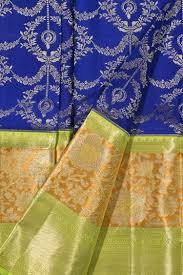1. Type of Silk: Different types of silk have varying quality levels. Some popular types include pure silk, Banarasi silk, Kanjeevaram silk, Tussar silk, and Chanderi silk. Pure silk sarees are generally considered of higher quality compared to blended silk sarees.
2. Weaving Technique: The weaving technique used to create the saree plays a significant role in its quality. Handwoven sarees, such as those made using traditional techniques like Jamdani or Baluchari, are usually considered higher quality than machine-made sarees.
3. Fabric Texture: High-quality silk sarees tend to have a smooth and lustrous texture. The fabric should feel soft and supple to touch. Inferior quality silk may have a coarse or rough texture.
4. Design and Patterns: The intricacy and complexity of the design can also indicate the quality of a silk saree. High-quality sarees often feature intricate and well-defined patterns, motifs, and borders.
5. Workmanship: Pay attention to the details and finishing of the saree. Check for any loose threads, uneven edges, or poorly done embroidery work. A well-crafted silk saree usually exhibits excellent workmanship and attention to detail.
6. Weight: Generally, good quality silk sarees tend to be slightly heavier due to the higher thread count. However, this may vary depending on the type of silk and the intended use of the saree.
7. Price: While price alone is not an absolute indicator of quality, it can give you some insight. In general, high-quality silk sarees tend to be more expensive due to the higher quality materials used and the craftsmanship involved.
Sure, here are a few more points to consider when determining the quality of a silk saree:
8. Color Fastness: High-quality silk sarees should have good color fastness, meaning the dyes used should not bleed or fade easily when washed or exposed to sunlight. To test this, you can lightly dampen a small section of the saree and rub it with a white cloth to see if any color transfers.
9. Silk Purity: If you want to ensure the saree is made of pure silk, look for a silk mark or certification tag that guarantees the authenticity of the fabric. You can also differentiate between pure silk and synthetic blends by burning a few threads of the saree. If it burns slowly, smells like burnt hair, and leaves behind a brittle residue, it is likely pure silk.
10. Thread Count: The thread count of a silk saree refers to the number of threads per square inch of fabric. Higher thread counts generally indicate better quality as it signifies a denser and finer weave. However, this may vary depending on the type of silk and the saree's intended purpose.
11. Reverse Side: Quality silk sarees often have a neat and well-finished reverse side as well. Check to ensure that the reverse side of the saree has clean and tightly woven threads without loose ends or knots.
12. Reputation of the Seller: When purchasing a silk saree, it can be helpful to research the reputation and credibility of the seller or brand. Look for customer reviews, feedback, or recommendations to ensure that you are buying from a trusted source.
13. Maintainability: The quality of the silk saree can also be assessed by its maintainability. A high-quality silk saree should be able to withstand gentle hand washing or dry cleaning without losing its sheen, color, or texture. Compromised stitches, loosening borders, or fabric damage after cleaning might indicate poorer quality.
Remember that it is always beneficial to personally examine the saree before making a purchase, as you can assess the fabric's overall look, feel, and quality firsthand.
It is also helpful to buy from reputable sources or trusted brands to ensure the authenticity and quality of the silk saree. Additionally, seeking recommendations or consulting with an expert in textiles can provide guidance when assessing the quality of a silk saree.




1 comment:
Quality in a silk saree comes from its weave, fabric purity, and craftsmanship. Chanderi Pure Silk Sarees for Women excel in all these aspects, offering authentic handwoven elegance, rich texture, and lasting beauty.
Post a Comment